10.3 Classification of Metamorphic Rocks
Metamorphic rocks are broadly classified as foliated or non-foliated. Non-foliated metamorphic rocks do not have aligned mineral crystals. Non-foliated rocks form when pressure is uniform, or near the surface where pressure is very low. They can also form when the parent rock consists of blocky minerals such as quartz and calcite, in which individual crystals do not align because they aren’t longer in any one dimension. This distinction breaks down in zones of intense deformation, where even minerals like quartz can be squeezed into long stringers, much like squeezing toothpaste out of a tube (Figure 10.13).
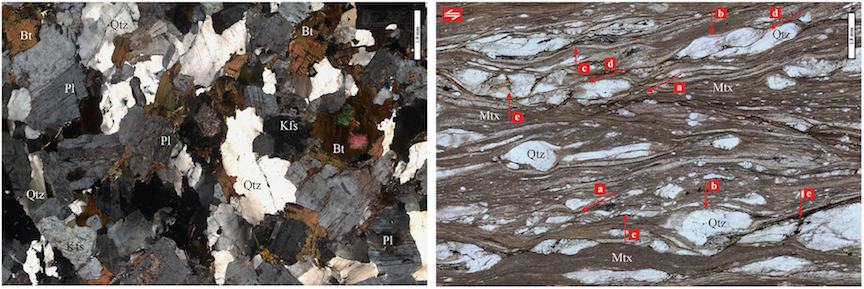
Types of Foliated Metamorphic Rocks
Four common types of foliated metamorphic rocks, listed in order of metamorphic grade or intensity of metamorphism are slate, phyllite, schist (pronounced “shist”), and gneiss (pronounced “nice”). Each of these has a characteristic type of foliation
Slate
Slate (Figure 10.14) forms from the low-grade metamorphism of shale. Slate has microscopic clay and mica crystals that have grown perpendicular to the maximum stress direction. Slate tends to break into flat sheets or plates, a property described as slaty cleavage.

Phyllite
Phyllite (Figure 10.15) is similar to slate, but has typically been heated to a higher temperature. As a result, the micas have grown larger. They still are not visible as individual crystals, but the larger size leads to a satiny sheen on the surface. The cleavage of phyllite is slightly wavy compared to that of slate.

Schist
Schist (Figure 10.16) forms at higher temperatures and pressures and exhibits mica crystals that are large enough to see without magnification. Individual crystal faces may flash when the sample is turned in the light, making the rock appear to sparkle. Other minerals such as garnet might also be visible, but it is not unusual to find that schist consists predominantly of a single mineral.
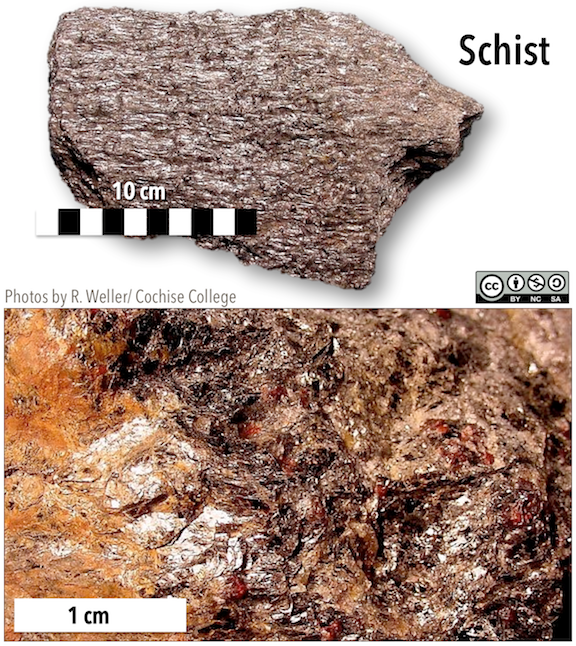
Gneiss
Gneiss (Figure 10.17) forms at the highest pressures and temperatures, and has crystals large enough to see with the unaided eye. Gneiss features minerals that have separated into bands of different colours. The bands of colours are what define foliation within gneiss. Sometimes the bands are very obvious and continuous (Figure 10.17, upper right), but sometimes they are more like lenses (upper left). Dark bands are largely amphibole while the light-coloured bands are feldspar and quartz. Most gneiss has little or no mica because it forms at temperatures higher than those under which micas are stable.
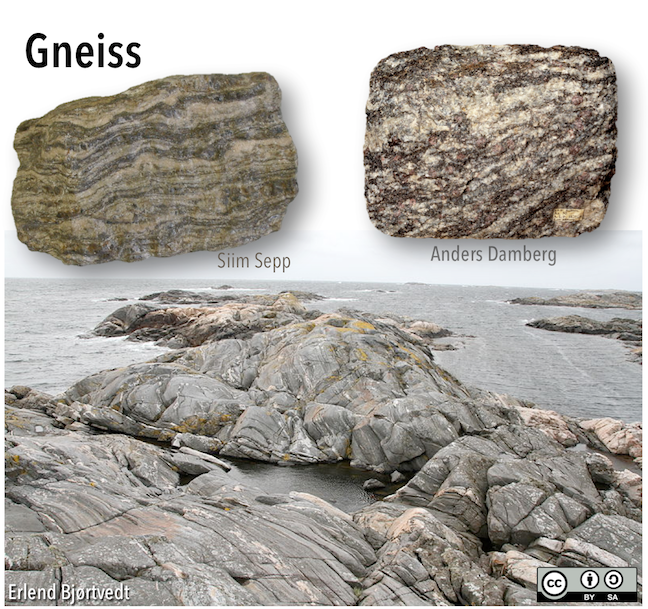
While slate and phyllite typically form only from mudrock protoliths, schist and especially gneiss can form from a variety of parent rocks, including mudrock, sandstone, conglomerate, and a range of both volcanic and intrusive igneous rocks.
Schist and gneiss can be named on the basis of important minerals that are present: a schist derived from basalt is typically rich in the mineral chlorite, so we call it chlorite schist. One derived from shale may be a muscovite-biotite schist, or just a mica schist, or if there are garnets present it might be mica-garnet schist. Similarly, gneiss that originated as basalt and is dominated by amphibole, is an amphibole gneiss or amphibolite (Figure 10.18).
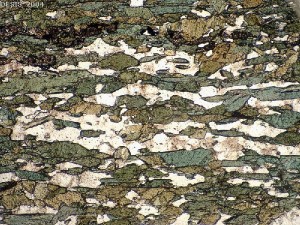
Types of Non-foliated Metamorphic Rocks
Metamorphic rocks that form under low-pressure conditions or under the effects confining pressure, which is equal in all directions, do not become foliated. In most cases, this is because they are not buried deeply enough, and the heat for the metamorphism comes from a body of magma that has moved into the upper part of the crust. Metamorphism that happens because of proximity to magma is called contact metamorphism. Some examples of non-foliated metamorphic rocks are marble, quartzite, and hornfels.
Marble
Marble (Figure 10.19) is metamorphosed limestone. When it forms, the calcite crystals recrystallize (re-form into larger blocky calcite crystals), and any sedimentary textures and fossils that might have been present are destroyed. If the original limestone is pure calcite, then the marble will be white. On the other hand, if it has impurities such as clay, silica, or magnesium, the marble could be “marbled” in appearance (Figure 10.19, bottom).
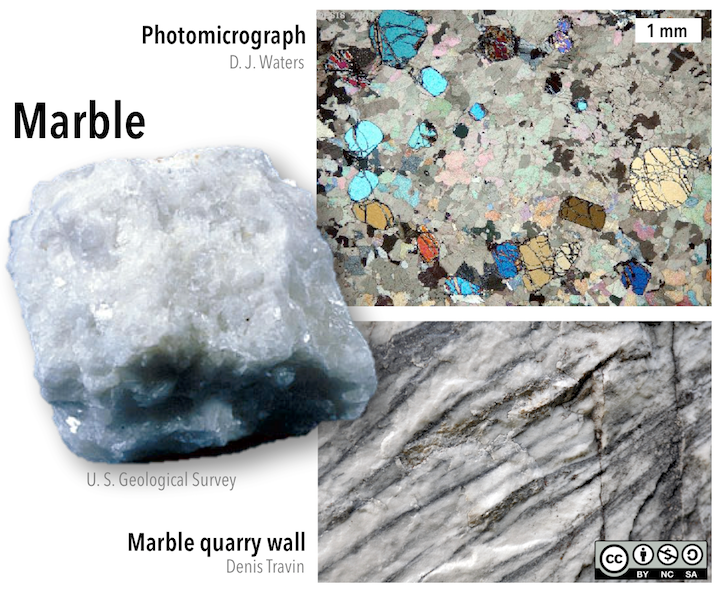
Quartzite
Quartzite (Figure 10.20) is metamorphosed sandstone. It is dominated by quartz, and in many cases, the original quartz grains of the sandstone are welded together with additional silica. Sandstone often contains some clay minerals, feldspar or lithic fragments, so quartzite can also contain impurities.
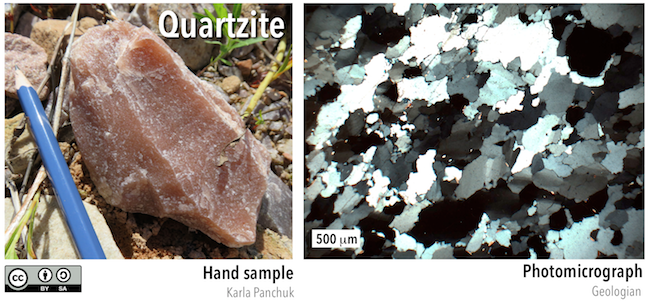
Even if formed under directed pressure, quartzite is generally not foliated because quartz crystals do not normally align with the directional pressure. On the other hand, any clay present in the original sandstone is likely to be converted to mica during metamorphism, and any such mica is likely to align with the directional pressure.
Hornfels
Hornfels is another non-foliated metamorphic rock that normally forms during contact metamorphism of fine-grained rocks like mudstone or volcanic rocks. Hornfels have different elongated or platy minerals (e.g., micas, pyroxene, amphibole, and others) depending on the exact conditions and the parent rock, yet because the pressure wasn’t substantially higher in any particular direction, these crystals remain randomly oriented.
The hornfels in Figure 10.21 (left) appears to have gneiss-like bands, but these actually reflect the beds of alternating sandstone and shale that were in the protolith. They are not related to alignment of crystals due to metamorphism. On the right of Figure 10.21 is a microscopic view of another sample of hornfels, also from a sedimentary protolith. The dark band at the top is from the original bedding. Here you can see that the brown mica crystals (biotite) are not aligned.
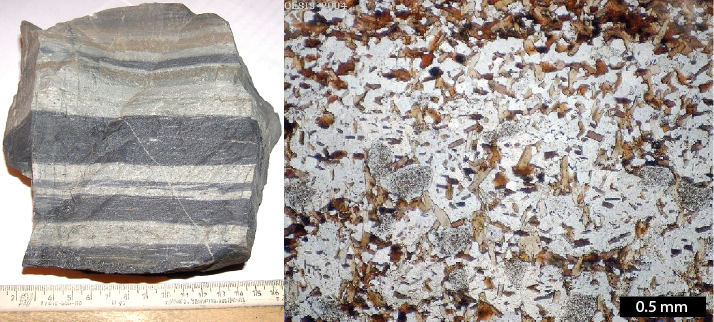
What Happens When Different Rocks Undergo Metamorphism?
The nature of the parent rock controls the types of metamorphic rocks that can form from it under differing metamorphic conditions (temperature, pressure, fluids). The kinds of rocks that can be expected to form at different metamorphic grades from various parent rocks are listed in Table 10.1.
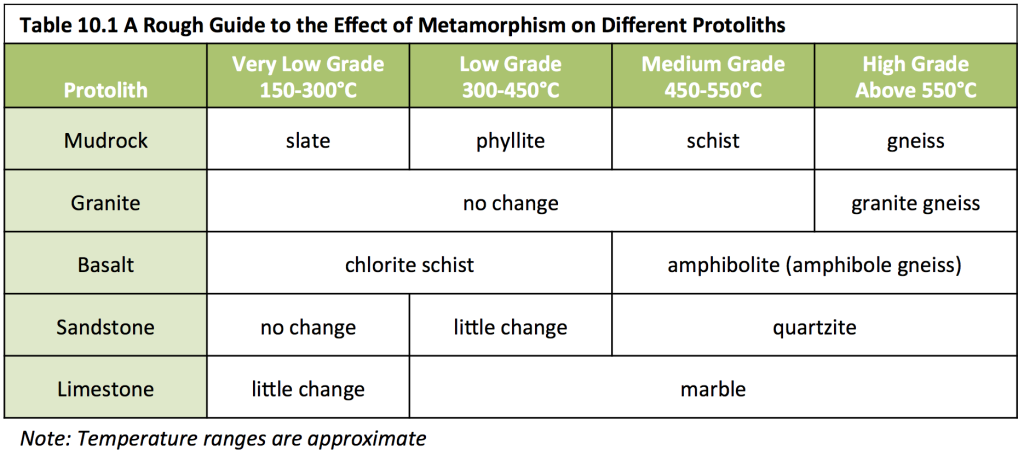
Some rocks, such as granite, do not change much at the lower metamorphic grades because their minerals are still stable up to several hundred degrees. Sandstone and limestone don’t change much either because their metamorphic forms (quartzite and marble, respectively) have the same mineral composition, but re-formed larger crystals.
On the other hand, some rocks can change substantially. Mudrock (e.g., shale, mudstone) can start out as slate, then progress through phyllite, schist, and gneiss, with a variety of different minerals forming along the way. Schist and gneiss can also form from sandstone, conglomerate, and a range of both volcanic and intrusive igneous rocks.
Migmatite: Both Metamorphic and Igneous
If a metamorphic rock is heated enough, it can begin to undergo partial melting in the same way that igneous rocks do. The more felsic minerals (feldspar, quartz) will melt, while the more mafic minerals (biotite, hornblende) do not. When the melt crystallizes again, the result is light-coloured igneous rock interspersed with dark-coloured metamorphic rock. This mixed rock is called migmatite (Figure 10.22). Note that the foliation present in the metamorphic rock is no longer present in the igneous rock. Liquids cannot support a differential stress, so when the melt crystallizes, the foliation is gone.

A fascinating characteristic of migmatites is ptygmatic (pronounced “tigmatic“) folding. These are folds look like they should be impossible because they are enveloped by rock which does not display the same complex deformation (Figure 10.23). How could those wiggly folds get in there without the rest of the rock being folded in the same way?
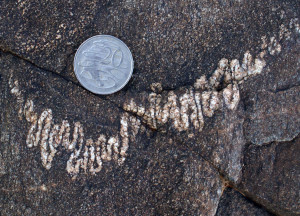
The answer to the ptygmatic fold mystery is that the folded layer is much stiffer than the surrounding layers. When squeezing forces act on the rock, the stiff layer buckles but the surrounding rock flows rather than buckling, because it isn’t strong enough to buckle.
Exercise: Naming Metamorphic Rocks
Which metamorphic rock is described in each of the following?
- A rock with visible minerals of mica and with small crystals of andalusite. The mica crystals are consistently parallel to one another.
- A very hard rock with a granular appearance and a glassy lustre. There is no evidence of foliation.
- A fine-grained rock that splits into wavy sheets. The surfaces of the sheets have a sheen to them.
- A rock that is dominated by aligned crystals of amphibole.
References
Farkašovský, R., Bónová, K., & Košuth, M. (2016). Microstructural, modal and geochemical changes as a result of granodiorite mylonitisation – a case study from the Rolovská shear zone (Čierna hora Mts, Western Carpathians, Slovakia). Geologos 22(3), 171-190. doi: 10.1515/logos-2016-0019 View full text

